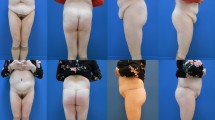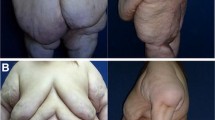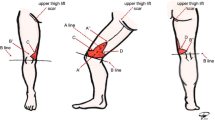Abstract
Background
After massive weight loss, both upper and lower limbs show a similar deformity which consists of redundancy and ptosis of the cutaneous mantle. Many disturbances are associated with this abnormality, which can be treated surgically. A retrospective review of limb-contouring procedures after massive weight loss is presented.
Methods
Thigh lift and arm lift procedures are described. All surgeries of upper and lower limbs contouring performed between 2003 and 2006 are reviewed with regard to quantity of tissue removed, comorbidities, complications and patients’ satisfaction, which was surveyed through a questionnaire exploring functional and esthetic results (maximum score 3).
Results
Among 48 bilateral limb-contouring procedures, medial thigh lifts were 35 (73%) and brachioplasties were 13 (27%). Mean age was 46 and average body mass index variation was 20 kg/m2. The most frequent comorbidity was gallstones (28%). In 46% of the whole group of patients, there was no complication to mention. The most frequent complication was acute anaemia in both procedures (43% in thigh lift and 54% in arm lift). Mean quantity of adipose–dermoid tissue removed was 766 g in thigh lift and 463 g in arm lift. In case of surgery combined with liposuction, the average aspirated volume was 1,933 ml (thighs) and 1,117 ml (arms). Patients’ satisfaction was 2.7 for thighs and 2.6 for arms, as average.
Conclusion
The rate of complications in limb contouring after weight loss is higher than the analogue esthetic procedures. Nevertheless, due to the rehabilitative significance of limb surgery after weight loss, this step is to be included as fundamental in obese patients’ surgical therapy.



Similar content being viewed by others
References
Datta G, Cravero L, Margara A, et al. The plastic surgeon in the treatment of obesity. Obes Surg. 2006;16:5–11.
Migliori F, Rosati C, D’Alessandro G, et al. Body contouring after biliopancreatic diversion. Obes Surg. 2006;16:1638–44.
Wolf AM, Kuhlmann HW. Reconstructive procedures after massive weight loss. Obes Surg. 2007;17:355–60.
Fraccalvieri M, Datta G, Bogetti P, et al. Abdominoplasty after weight loss in morbidly obese patients: a 4 year clinical experience. Obes Surg. 2007;17:1319–24.
Datta G, Boriani F, Obbialero FD, et al. Body contouring after weight loss in morbid obesity: gain in health and leap in psychosocial functioning (correspondence). Obes Surg. 2006;16:673.
Song A, Raymond J, Hurwitz D, et al. A classification of contour deformities after bariatric weight loss: the Pittsburg rating scale. Plast Reconstr Surg. 2005;116:1535–44.
Teimourian B, Malekzadeh S. Rejuvenation of the upper arm. Plast Reconstr Surg. 1998;102:545–51.
El Khatib H. Classification of brachial ptosis: strategy for treatment. Plast Reconstr Surg. 2007;119:1337–42.
Kaluf R et al Classificacao de Kaluf/Lisboa em braquioplastia pos-obesidade morbida. 42° Brasilian Conference of Plastic Surgery. Belo Horizonte Brazil
Correa-Iturraspe M, Fernandez JC. Dermolipectomia braquial. Prensa Med Argentina 1954;41:2432.
Strauch B, Greenspun D, Levine J, Baum T. A technique of brachioplasty. Plast Reconstr Surg. 2004;113:1044–8.
Abramson DL. Minibrachioplasty: minimizing scars while maximizing results. Plast Reconstr Surg. 2004;2114:1631–4.
Hurwitz DJ, Holland SW. The L brachioplasty: an innovative approach to correct excess tissue of the upper arm, axilla and lateral chest. Plast Reconstr Surg. 2006;117:403–11.
Pitanguy I. Aesthetic plastic surgery of the upper and lower limbs. Aesthetic Plast Surg. 1980;4:363–72.
Regnault P, Baroudi R, da Silveira Carvalho CG. Correction of lower limb lipodystrophy. Aesthetic Plast Surg. 1979;3:233–49.
Lockwood TE. Fascial anchoring technique in medial thigh lifts. Plast Reconstr Surg. 1988;82:299–304.
Le Louarn C, Pascal JF. The concentric medial thigh lift. Aesthetic Plast Surg. 2004;28:20–3.
Knoetgen J, Moran SL. Long-term outcomes and complications associated with brachioplasty: a retrospective review and cadaveric study. Plast Reconstr Surg. 2006;117:2219–23.
Author information
Authors and Affiliations
Corresponding author
Rights and permissions
About this article
Cite this article
Bruschi, S., Datta, G., Bocchiotti, M.A. et al. Limb Contouring after Massive Weight Loss: Functional Rather than Aesthetic Improvement. OBES SURG 19, 407–411 (2009). https://doi.org/10.1007/s11695-008-9631-7
Received:
Accepted:
Published:
Issue Date:
DOI: https://doi.org/10.1007/s11695-008-9631-7




